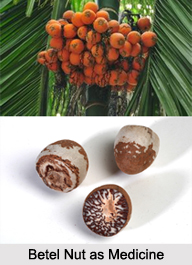 The chief consumption of Areca Catechu or betel-nuts is as a masticatory, alone or in conjunction with betel leaf. The unripe nuts are said to be laxative and carminative. The fresh nuts when not yet dry in their interior, have intoxicating properties and produce giddiness. The dried nuts are masticated. They are said to sweeten the breath, strengthen the gums, remove bad tastes from the mouth, and produce a stimulant or exhilarant effect the system. The burnt nuts are used as a tooth powder.
The chief consumption of Areca Catechu or betel-nuts is as a masticatory, alone or in conjunction with betel leaf. The unripe nuts are said to be laxative and carminative. The fresh nuts when not yet dry in their interior, have intoxicating properties and produce giddiness. The dried nuts are masticated. They are said to sweeten the breath, strengthen the gums, remove bad tastes from the mouth, and produce a stimulant or exhilarant effect the system. The burnt nuts are used as a tooth powder.
Dose of Betel Nut in Medicine
Medicinally betel-nuts are used in urinary disorders and as an aphrodisiac. The Bhavaprakasa gives a preparation called "Rativallava Pugapaka". It is a confection made of betel-nuts boiled in milk, with the addition of a number of aromatic and stimulant substances supposed to have aphrodisiac properties. Sometimes datura seeds and the leaves of Cannabis sativa are added to this confection when it is called "Kamesvara Modaka".
Betel-nuts are also used as vermifuge. Their dose should be one-fourth tola rubbed into a paste with tolas of fresh lemon juice.
This article is a stub. You can enrich by adding more information to it. Send your Write Up to content@indianetzone.com
Related Articles
Ayurveda
Sushruta Samhita
Classification of Medicine
Properties of Material Objects and its Effect on Human Body
Indian Herbs
Traditional Indian Medicines




















